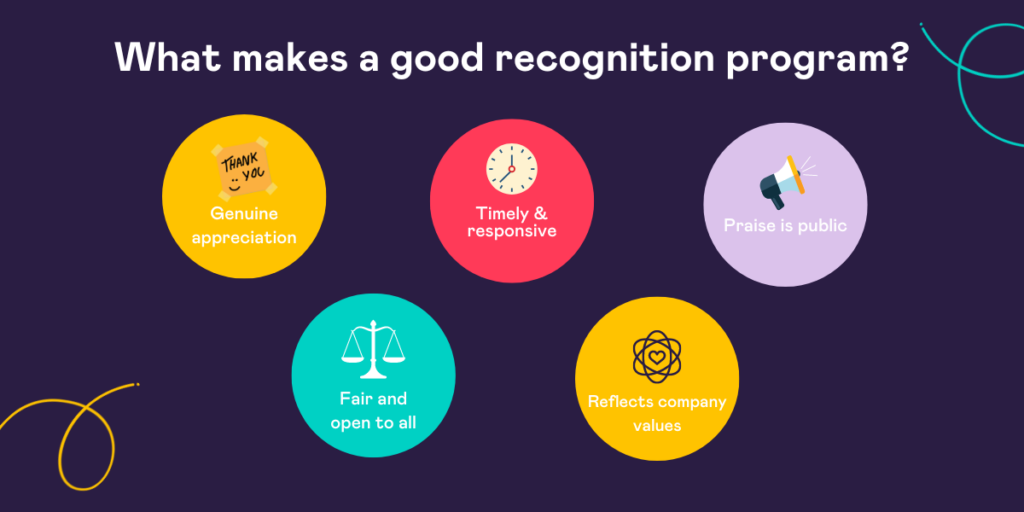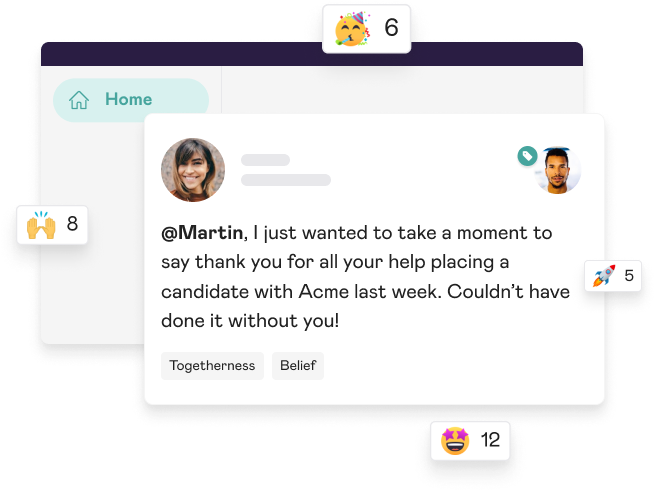Your employees are your company. If this wasn’t clear before, the past few years’ events have provided unequivocal evidence. The companies that have thrived during these times have highly-skilled, well-motivated employees.
We can upskill our outstanding team members with specialised training and development opportunities, but keeping them happy and motivated is essential. Ping pong tables and hang-out areas are simply not enough, and more companies now realise that employee recognition needs to be at the forefront of their business.
Employee recognition is an essential part of making sure that your employees feel respected and valued. Let’s look into why appreciating your employees is so important and how you can create a culture of recognition and gratitude.

Rewards & Recognition: How to Make Your Program Successful
Struggling with your reward and recognition program? Find out how to make your program successful in our FREE guide!
What is employee recognition?
Employee recognition is a sign of appreciation and gratitude to your employees for their efforts and achievements within your organisation. It is anything that shows your team members that you value how hard they’ve been working.
Implementing the right kind of recognition program is crucial in giving your company a competitive edge over others. They’re a powerful tool for improving employee engagement, reducing staff turnover, increasing productivity, and building purpose when used correctly.
Although most recognition schemes operate top-down, that isn’t the only way to help keep your employees motivated. Recognition from co-workers and peers can sometimes be even more effective at encouraging team members, creating an enthusiastic and supportive workplace.
Why is employee recognition important?
Introducing proper processes for recognising your staff into your daily practices can considerably impact many areas across the business.
The connection between employee recognition and engagement
An engaged employee is a happy employee. Right? Engagement is one of the essential qualities you should want from your workers –– and there’s no faster way to get there than with proper recognition.
Consider the results from Bayhealth Medical. When the organisation implemented a formal recognition program, employees reported feeling a greater sense of belonging and connection to the company and with their coworkers. This can increase engagement and, in turn, staff satisfaction. But it also can’t be a once-and-done exercise.
Recognition needs to be ongoing rather than a one-off acknowledgement. A 2020 UK workplace culture study found that half of the employees who had been recognised within the past week were very engaged. Fantastic numbers. But unfortunately, those numbers dropped to less than a third of employees recognised in the last month, and just 16% in the last year.
Recognition can lower the turnover of staff
The proof is in the pudding. Employees want to feel appreciated, but more than that, be recognised. It’s important to not just show appreciation for your top performers, as that can lower morale among other staff. More than half of employees want more recognition from their direct manager, which means more than half of workers may soon be driven to quit their jobs if they don’t get it.
Ask yourself, what are you doing as a business to recognise your employees?
It’s a perk for potential candidates
There are many things professionals look for when job-hunting: salary, perks, company culture… the good stuff. Increasingly, people are looking for more. It’s become apparent that new applicants seek out jobs in organisations with established employee recognition programs –– you might write it off. Still, it continues to be one of the most important employer traits candidates looked for in 2021.
If you’re hoping to recruit the top talent into your organisation — and keep them on board — having a good track record of employee appreciation is essential.
Increased productivity
Happier workers are more productive at work. And not just marginally. Happiness makes staff around 13% more productive. Big hitters such as Google now invest more in employee support, and satisfaction has risen by an eye-watering 37% as a result.
Your organisation can foster a higher sense of well-being and happiness by simply instating an employee recognition program, leading to more productivity across the board. A small investment in a recognition program can pay massive dividends.
Improved employee satisfaction
We all go into work wanting to have some purpose. Whatever our job role is, it’s important to make a difference –– but if no one recognises that, what’s the point in continuing? Multiple workplace studies have proven this direct link between recognition and a sense of purpose.
A recent study found that three-quarters of US employees who were happy with the amount of praise their teams received also strongly agreed that they felt their work was valuable and useful.
Build your company culture
Despite what some tech startups may think, company culture isn’t just about having free beers on Thursdays, nap pods or an office ping pong table (although they are pretty great). The culture of a company is built on the back of employee satisfaction.
If people aren’t happy with management practices and don’t feel adequately recognised for their work, it will be near-impossible to build a positive culture in the workplace.
Decreased absence of staff
More engaged staff leads to staff more eager to come to work. Period. While many absences can be attributed to sick days or personal issues, there’s no denying that a lack of employee satisfaction can lead to this increased absence rate.
According to a Gallup report, businesses with employees actively engaged in their work have lower employee absenteeism rates –– by up to 41%. That’s nothing to be scuffed at.
What does recognition look like?
So what exactly does employee recognition look like? Recognition schemes or programs can take on many forms, but it’s one of the most important and valuable areas a team can focus on.

Traditional recognition programs typically offer rewards, such as vouchers, as a concrete symbol of your appreciation, but recognition at work doesn’t end there. Sometimes, it’s as simple as a handwritten note saying thank you, or a shout-out for great work that’s shared with the rest of the company.
It’s not a one-size-fits-all exercise. You want to set up a recognition program that will offer different rewards for different occasions. Not only do you want to have a solid recognition scheme in place, but you will also want to build a supportive atmosphere that encourages your employees to do their best. Ask your employees what they want, and decide from there what it is you can deliver. Here are a few examples:
Monetary Rewards
One of the most common staff reward schemes set out by companies is a tangible reward for doing a great job, such as receiving a gift card for a local restaurant or a voucher for a free coffee.
Awards
Another standard company reward idea is an employee of the month award, which usually involves all employees voting for who they think deserves it this month and potentially writing down why. Some organisations may even go further than this and offer a team of the month award, which can help boost team morale and spirit.
Verbal Praise
How often would you actually say thanks to one of your colleagues or employees? Verbal praise can make a bigger difference than you think, and you should never underestimate how powerful a simple ‘well done’ can be! It’s a genuine form of appreciation, and the best way to do it is by explaining what you’re thankful for.
Written Praise
If you’re going to give an employee written praise, you could do it through Mo! On our platform, you can send your message of appreciation and gratitude to an employee for the whole company to see, meaning it won’t get lost in an inbox or Slack channel. When appreciation is given in the moment, it has the most significant potential for impact because the action is rewarded almost immediately.
What defines an effective and successful employee recognition scheme?

Recognition in the workplace is hugely important, but as we said, you need to get it right. Not all staff recognition schemes are equal. If you want to show your appreciation in ways that will motivate your staff, here are some features of a great staff recognition scheme to keep in mind.
It reflects genuine appreciation
One of the most important aspects of showing your appreciation for your staff members is sincerity. One of the reasons why traditional staff reward schemes miss the mark is because they feel formulaic and insincere.
This is why recognition is often deemed better than reward. Team members can interpret a voucher as a routine part of a scheme, whilst saying thank you, whether face-to-face or in a message, feels like a genuine gesture of appreciation.
Rather than ‘going through the motions’, focus on paying attention to the staff members you’re grateful for. This creates a sense of connection, which is key for successful recognition.
It’s timely and responsive
It might be convenient for management to run monthly or quarterly reward and recognition processes. Unfortunately, this creates disconnect between your team member’s efforts and your appreciation.
Some gestures of thanks might take a little time to organise, but make sure that you’re showing your appreciation straight away. Take a few minutes to say thank you or highlight their efforts to the rest of the team.
It’s public
Not all recognition has to be public, but some of it should be. Making a public statement about an employee’s great performance can help to build team cohesion and motivate the rest of your team at the same time. Making your praise public ensures that everyone knows what it takes to excel and creates a culture of appreciation.
It’s fair and open to all
Having an excellent recognition scheme can be counterproductive if not everyone can participate.
The best staff recognition schemes encourage employees to show their appreciation to each other (peer to peer recognition), rather than relying just on top-down awards. Demonstrating that team members can also appreciate each other’s efforts is one of the fastest ways to build team identity and cohesion.
Great schemes are also broad enough to reward a wide range of employees and different types of success. This isn’t about lowering the bar so everyone can be recognized. Instead, the aim is to be able to reward the myriad of ways that great employees can make a difference.
It reflects the company’s values
Your employee recognition scheme is custom-designed to reinforce your company’s values. This is your chance to demonstrate that your values are more than a slogan.
Plan your scheme to reflect those values. If you value teamwork and collaboration, make sure that those qualities are rewarded regularly and publicly.
Whatever your values, recognise those team members who best embody them to create a strong company culture.
How does recognition impact your bottom line?
Ever wondered how much employee turnover is costing your business?
We touched lightly on the ways recognition can increase productivity and lower turnover, but did you know effective employee recognition schemes can save you money – and your best people – in the long run?
Recognition is free, and rewards also don’t have to be expensive – they just have to be genuine. Giving your employees a ‘thank you’ for their hard work on a project will go further than gifting an expensive bottle of champagne to the employee who doesn’t drink. Now, we’re not saying rewards aren’t a good idea. They just aren’t what a strong employee appreciation program is all about.
If you take the time to research different employee recognition tools, invest in a system your employees will engage with and continuously measure the success of your program, your ROI will improve. As a result, your employees will become more engaged with the organisation and want to grow with your company.
Don’t believe us? Check out our ROI calculator!
Want to take your employee recognition scheme to the next level?
Transform your culture with Mo

- Improve employee engagement scores
- Reduce employee churn
- Build a collaborative culture
Mo is a new kind of reward and recognition platform that makes it easy for busy managers to meaningfully recognise, engage and connect with their teams.
We equip managers with weekly suggestions to energise and connect with their people, help teams build habits of recognition into their day-to-day rhythms and go beyond simple rewards as a way to motivate staff.
Join companies like SHL, OVO Energy and William Hill in delivering meaningful improvement on engagement results with Mo. Book a free demo today!




